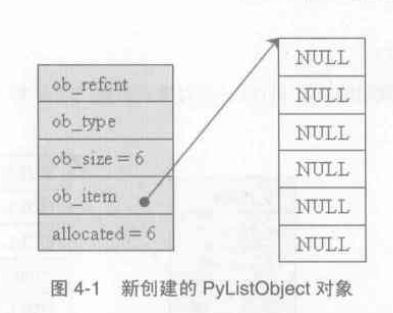1.Python中的List对象(变长对象的可变对象)
a.PyListObject对象
/* PyListObject定义 */
[listobject.h]
typedef struct{
PyObject_VAR_HEAD //其中ob_size为已经占用的申请内存
//ob_item为指向元素列表的指针,实际上,Python中的list[0]就是ob_item[0]
PyObject **ob_item;
int allocated; //allocated为一次申请的所有内存
}
b.PyListObject对象的创建与维护
创建对象
[listobject.c]
PyObject* PyList_New(int size){
PyListObject* op;
size_t nbytes;
//内存数量计算,溢出检查
nbytes = size * sizeof(PyObject*);
if(nbytes / sizeof(PyObject*) != (size_t)size)
return PyErr_NoMemory();
//为PyListObject对象申请空间
if(num_free_lists){
//缓冲池可用
num_free_lists--;
op = free_lists[num_free_lists];
_Py_NewReference((PyObject *)op);
}else{
//缓冲池不可用
op = PyObject_GC_New(PyListObject, &PyList_Type);
}
//为PyListObject对象中维护的元素列表申请空间
if(size <= 0)
op->ob_item = NULL;
else{
op->ob_item = (PyObject **) PyMem_MALLOC(nbytes);
memset(op->ob_item,0,nbytes);
}
op->ob_size = size;
op->allocated = size;
return (PyObject *)op;
}
/* free_lists最多会维护80个PyListObject对象 */
[listobject.c]
#define MAXFREELISTS 80
static PyListObject* free_lists[MAXFREELISTS];
static int num_free_lists = 0;
设置元素

/* 设置元素 */
[listobject.c]
int PyList_SetItem(register PyObject* op, register int i, register PyObject* newitem){
register PyObject* olditem;
register PyObject** p;
//索引检察
if( i < 0 || i >= ((PyListObject *)op) -> ob_size){
PyErr_SetString(PyExc_IndexError, "list assignment index out of range");
return -1;
}
//设置元素
p = ((PyListObject *)op)->ob_item + i;
olditem = *p;
*p = newitem;
Py_XDECREF(olditem);
return 0;
}
/* 插入元素 */
[listobject.c]
int PyList_Insert(PyObject* op, Py_ssize_t where, PyObject* newitem){
......//类型检查
return ins1((PyListObject *)op,where,newitem);
}
static int ins1(PyListObject* self, Py_ssize_t where, PyObject* v){
Py_ssize_t i,n = self->ob_size;
PyObject** items;
.....
//调整列表容量
if(list_resize(self,n+1) == -1)
return -1;
//确定插入点
if(where < 0){
where += n;
if(where < 0)
where = 0;
}
if( where > n){
where = n;
}
//插入元素
items = self->ob_item;
for(i = n; --i >= where; )
items[i+1] = items[i];
Py_INCREF(v);
items[where] = v;
return 0;
}
static int list_resize(PyListObject* self, int newsize){
PyObject** items;
size_t new_allocated;
int allocated = self->allocated;
//不需要重新申请内存
if(allocated >= newsize && newsize >= (allocated >> 1)){
self->ob_size = newsize;
return 0;
}
//计算重新申请的内存大小
new_allocated = (newsize >> 3) + (newsize < 9 ? 3 : 6 ) + newsize;
if(newsize == 0)
new_allocated = 0;
items = self->ob_item;
PyMem_RESIZE(items,PyObject*,new_allocated); //最终调用C中的realloc
self->ob_item = items;
self->ob_size = newsize;
self->allocated = new_allocated;
return 0;
}
/* append方法 */
[listobject.c]
//Python提供的C API
int PyList_Append(PyObject* op, PyObject* newitem){
if(PyList_Check(op) && (newitem != NULL))
return app1((PyListObject *)op,newitem);
return -1;
}
//与append对应的c函数
static PyObject* listappend(PyListObject* self, PyObject* v){
if(app1(self,v) == 0)
Py_RETURN_NONE;
return NULL;
}
static int app1(PyListObject* self,PyObject* v){
int n = PyList_GET_SIZE(self);
......
if(list_resize(self,n+1) == -1)
return -1;
Py_INCREF(v);
PyList_Set_ITEM(self,n,v);
return 0;
}
删除元素
[listobject.c]
static PyObject* listremove(PyListObject* self, PyObject* v){
int i;
for(i = 0; i < self.ob_size; i++){
//比较list中的元素与删除元素
int cmp = PyOBject_RichCompareBool(self->ob_item[i],v,Py_EQ);
if(cmp > 0){
if(list_ass_slice(self,i,i+1,(PyObject* )NULL) == 0)
Py_RETURN_NONE;
return NULL;
}
else if(cmp < 0)
return NULL;
}
PyErr_SetString(PyExc_ValueError, "list.remove(x) : x not in list");
return NULL;
}
int list_ass_slice(PyListObject* a, Py_ssize_t ilow, Py_ssize_t ihigh, PyObject* v)
/* 两种语义 */
1.a[ilow:ihigh] = v if v != NULL
2.del a[ilow:ihigh] if v == NULL
PyListObject对象缓冲池
[listobject.c]
static void list_dealloc(PyListObject* op){
int i;
//销毁PyListObject对象维护的元素列表
if(op->ob_item != NULL){
i = op->ob_size;
while(--i >= 0){
Py_XDECREF(op->ob_item[i]);
}
PyMem_FREE(op->ob_item);
}
//释放PyListObject自身
if(num_free_lists < MAXFREELISTS && PyList_CheckExact(op))
free_lists[num_free_lists++] = op;
else
op->ob_type->tp_free((PyObject *)op);
}